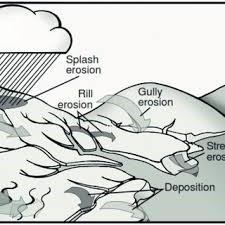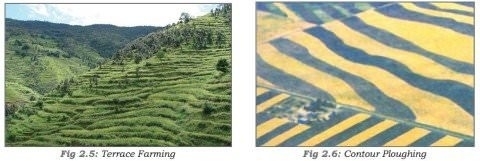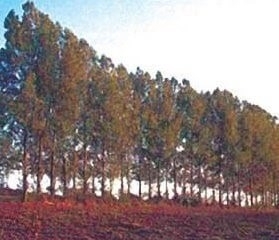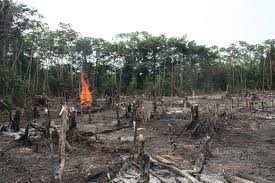- Home/
- Other State Exams (Other State PSC)/
- Article
Soil Erosion and Its Conservation
By BYJU'S Exam Prep
Updated on: September 13th, 2023

Table of content
Soil Erosion is an important topic for UPSC Prelims and So to help you prepare for IAS Prelims Geography, we are providing you with a complete note on Soil Erosion in Hindi and English. Soil erosion is defined as the wearing away of the topsoil from the surface. Topsoil is the most fertile portion of the soil because it contains the most organic, nutrient-rich materials. Soil erosion may be a slow process or a fast process promoted by deforestation, floods, tornadoes or other human activities.
Soil Erosion: Types of Soil Erosion: Water Erosion and Wind Erosion; Effects of Soil Erosion; Control of Soil Erosion
Type of Soil Erosion:
Water Erosion

Running water is among the main agents of soil erosion. Erosion by water occurs due to raindrop, waves or ice. Soil erosion due to water is categorised differently as per the intensity and nature of erosion. They can be classified as:
- Raindrop erosion
- They are like tiny bombs when falls on exposed soil, displaces soil particles and destroy the structure of the soil.
- Sheet erosion:
- This is the type of erosion which results from the runoff that spreads across the surface of the soil during rainfall (i.e. when the rate of infiltration has been exceeded).
- The detachment and transportation of soil particles from the surface by flowing rainwater are called a sheet or wash off erosion. This is rather a very slow process which often remains unnoticed.
- Rill erosion
- Rill erosion is caused by the concentrated flow of water in small rivulets. Here, finger-like rills appear on the cultivated land after it has undergone sheet erosion.
- Over a period of time, these rills start getting more wider and deeper.
- Gully Erosion:
- When Rills increase in size, they are called Gullies. It is deeper and has wider cuts. Gullies further if kept unchecked becomes more entrenched and thus deep gullies which are known as Ravines.

- Mass Movement
- In this type, erosion is caused by soil saturation and gravity which set off due to intense and/or prolonged rainfall. Example: Landslide, mudflow etc.
- Landslide is a sudden mass movement of the topsoil from the surface because of the instability or loss of balance of landmass with respect to gravity.
Wind Erosion
Soil erosion due to the wind is very common in areas where there is a lack of natural vegetation. It occurs mainly in dry and arid regions along the sandy shores of oceans, lakes and rivers. The soil particles after getting loose are blown and carried away by the wind in the following three ways:
- Siltation
- Drainage is poor and high temperatures prevail in the arid regions of low rainfall resulting in evaporation of water whilst leaving behind the salts. Salt accumulation occurs mostly in lowlands around the oceans. The salts are mainly chlorides, sulphates; carbonates, and nitrates.
- Suspension
- The smaller soil particles suspended into the air and move like a fine crust with the wind and are transported to long distances.
- Surface creep
- The heavier particles of soil that are not easily thrown up by wind are simply pushed or spread along the surface by the wind.
Consequences of Soil Erosion:
- Erosion removes the most fertile portion of the soil which contains the bulk of nutrients and organic matter needed by the plants are lost from soil erosion and the less fertile subsoil is left.
- Erosion results in the removal of seeds or seedlings and makes soil bare which is more vulnerable to erosion. It also reduces the ability of soil to store water.
- Sheet, rill, gully and stream bank erosion causes siltation of rivers, streams and fields.
- Deposition of silt results in damaging of Agricultural crops and sedimentation of water bodies results in deterioration of water quality and also damage aquatic habitats and organisms.
- Wind erosion removes the finer soil leaving behind coarser and less fertile material.
- Wind erosion also damages roads and agricultural fields by depositing large quantities of air blown soil particles.
Soil Conservation:
It is the prevention of soil from erosion or reduced fertility caused by overuse, acidification, salinisation or other chemical soil contamination. Soil erosion is the greatest threat to Indian agriculture and animal husbandry. Some of the soil conservation Methods are:
- Afforestation
- It is the prevention of forest destruction along with growing new forests or increase area under forests.
- A minimum area of 20 to 25 per cent of forest land is considered healthy for soil and water conservation for the whole country.
- Crop Rotation
- Sustainable agricultural practices adoption is the most important measure which helps to conserve soil.
- Under Crop rotation, different crops are cultivated on a piece of land each year that helps in conservation of soil fertility as different crops require different nutrients from the soil and provide enough time to restore lost nutrients. For example, potatoes require more potash but wheat requires more nitrate. Thus they are best alternate crops in the field.
- Building Dams
- Soil erosion by river floods can be avoided by constructing dams across the rivers at proper places. The dam will check the speed of water and will prevent erosion.
- Contour Bunding
- Under this, the many banks along the contours are constructed which divide the hill slope into numerous small slopes to check the flow of water and promote absorption of water by soil thus prevent soil from erosion.
- Checking Overgrazing
- During the dry period when there is a shortage of fodder, the grass is grazed to the ground and torn out to the roots by animals. All this leads to the weak top thus lead to soil erosion.
- Thus overgrazing needs to be checked to prevent soil erosion which can be done by creating separate grazing grounds and producing larger quantities of fodder for animals.
- Mulching
- The topsoil between plants is covered with a protective layer of organic matter like grass clippings, straw, etc. protects the soil from erosion and helps to retain soil moisture. It also helps to maintain a more even soil temperature and prevents weed growth.
- Contour barriers
- Rock, stones soil etc are used to build barriers along contours and also trenches are made in front of the barriers to collect water. These barriers slow down the movement of water and reduce its erosive force which prevents soil erosion.
- Terrace farming
- In terrace farming, a number of terraces are cut along the hill slope so that flat surfaces are available to grow crops. They reduce surface run-off and soil erosion.

- Contour Ploughing
- If ploughing is done in a perpendicular direction to the hill slope, it prevents excessive soil loss as gullies are less likely to develop and also reduce run-off so that plants receive more water.
- Shelterbelts or Windbreaks
- In coastal and dry areas, large rows of trees are planted in order to check the wind movement to protect soil cover thus preventing soil erosion.

- Strip Cropping
- In this crops is cultivated in alternate strips, parallel to one another. Various crops are harvested at different intervals which ensures that at no time the entire area is left bare or exposed.
- The tall-growing crops act as windbreaks and strips which are parallel to the contours help in increasing water absorption by the soil as they slow down the runoff.
- Checking Shifting Cultivation
- Checking and reducing shifting cultivation is a very effective method of soil conservation. This can be done by planning for the settlement of tribal people.

- Use of Early Maturing Varieties
- Early maturing varieties of crops take less time to mature, thus they put less pressure on the soil and can help in reducing the soil erosion.
Classification of Soil in India
Check Other Important Articles for UPSC Prelims 2020: Click Here
More from Us:
UPSC EPFO 2020: A Comprehensive Course
UPSC EPFO 2020: Accounting, Industrial Relations, Labour Law & Social Security
Are you preparing for State PCS exam,
UPSC & State PCS Test Series (100+ Mock Tests)
Check other links also:


